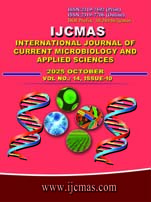Susceptibility Pattern of Novel Ceftriaxone Sulbactam EDTA by E-Strip Method on Extended Spectrum Beta Lactamase and Carbapenem Resistant Enterobacterales Isolated in a Tertiary Care Hospital, Calicut
1Department of Microbiology, MIMS college of Allied Health Sciences, Kerala University of Health Sciences, Malappuram, India 2Department of Microbiology, Aster MIMS Hospital, Calicut, India 3Department of Microbiology, MIMS college of Allied Health Sciences, Malappuram, India
*Corresponding author
Abstract:
The increasing prevalence of Extended-spectrum beta-lactamase (ESBL) producers and Carbapenem-resistant Enterobacterales, poses a significant threat to public health and challenges in antimicrobial therapy. These resistant organisms are commonly encountered in hospital settings and are associated with high morbidity, mortality, and healthcare costs. Ceftriaxone-sulbactam-EDTA (CSE), a novel beta-lactam/beta-lactamase inhibitor combination with an added metal ion chelator, has shown promising activity against these resistant pathogens. Evaluating the in-vitro susceptibility pattern of CSE using the E-strip method provides crucial data for its potential role in the management of infections caused by ESBL and carbapenem-resistant Enterobacterales. To study the proportion of Extended-spectrum beta-lactamase production and carbapenem resistant Enterobacterals among culture isolates and to determine the minimum inhibitory concentration of ceftriaxone sulbactam EDTA in extended spectrum beta lactamase and carbapenem resistant Enterobacterals by E strip method. Samples are examined using standard bacteriological methods to identify the causative organisms. Antimicrobial susceptibility is tested using Kirby-Bauer disc diffusion method, with results interpreted according to CLSI guidelines. The VITEK® 2 Compact automatic system is employed for testing blood, body fluids and invasive respiratory specimen. Screening of ESBL is done by ceftazidime and ceftazidime clavulanic acid combined disc test. Screening of CRE is done by imipenem (IMP) and meropenem (MEM) disc diffusion and its Phenotypic characterization is done by mCIM and eCIM method. The Minimum inhibitory concentration of ceftriaxone sulbactam EDTA is done by E strip. A total of 183 multidrug-resistant (MDR) Enterobacterales isolates were obtained from diverse clinical specimens, without limiting by age or gender. Out of these, 96 (52.5%) were Extended Spectrum Beta-Lactamase (ESBL) producers, while 87 (47.5%) were classified as Carbapenem-Resistant Enterobacterales (CRE). All ESBL-producing isolates were fully susceptible to ceftriaxone-sulbactam-EDTA, with a predominant minimum inhibitory concentration (MIC) of 1 µg/ml. Among CRE isolates, 87.5% of MBL producers were sensitive to ceftriaxone-sulbactam-EDTA, with a typical MIC of 8 µg/ml, whereas SBL producers exhibited complete resistance to the same. This study identified a high prevalence of Extended Spectrum Beta-Lactamase (52%) and Carbapenem-Resistant Enterobacterales (47%) among clinical Enterobacterales isolates, underscoring the growing challenge of antimicrobial resistance and highlights the significant therapeutic potential of the novel antibiotic combination Ceftriaxone-Sulbactam-EDTA (CSE), evaluated using the E-strip method, in addressing multidrug-resistant Enterobacterale infections. The results demonstrated that CSE exhibited 100% sensitivity against Extended Spectrum Beta-Lactamase (ESBL)-producing Enterobacterales and showed promising efficacy against Carbapenem-Resistant Enterobacterales (CRE), particularly metallo-beta-lactamase (MBL) producers. This would help the clinician to make it as carbapenem sparer and an alternative drug for polymyxins which act against Carbapenem resistant Enterobacterales
Keywords: Extended Spectrum Beta-Lactamase, Carbapenem-Resistant Enterobacterales, Ceftriaxone-Sulbactam-EDTA, minimum inhibitory concentration, E-Strip
References:
- Win WC, Allen SD, Janda WM, Koneman EW, Procop GW, Schreckenberger PC, Woods G, editors. Color atlas and textbook of diagnostic microbiology. 6th edition Philadelphia: Lippincott William and Wilkins; Enterobacteriaceae 2006 Pg 211-302
- Logan LK, Weinstein RA. The Epidemiology of Carbapenem-Resistant Enterobacteriaceae: The Impact and Evolution of a Global Menace. J Infect Dis. 2017 Feb 15; 215 (suppl_1): S28-S36. doi: 10.1093/infdis/jiw282. PMID: 28375512; PMCID: PMC5853342. https://doi.org/10.1093/infdis/jiw282
- Prioritization of pathogens to guide discovery, research and development of new antibiotics for drug-resistant bacterial infections, including tuberculosis. Geneva: World Health Organization; 2017. Available from: https:// www.who.int/publications/i/item/WHO-EMP-IAU-2017.12
- S Nema, P Nema, K Mehdi, K Tripathi, VK Ramnani In Vitro Antimicrobial Susceptibility of Ceftriaxone Sulbactam EDTA (CSE 1034) And Other Β Lactam/Β Lactamase Inhibitors And Carbapenems Against Enterobacteriaceae: A Comparative Study Volume 4~ Issue 7 (2017) Aug. pp: 18-22
- Sampah, J., Owusu-Frimpong, I., Aboagye, F. T., & Owusu-Ofori, A. (2022). Prevalence of carbapenem-resistant and extended-spectrum beta-lactamase-producing Enterobacteriaceae in a teaching hospital in Ghana. medRxiv.
- Shilpakar, A., Ansari, M., Rai, K.R. et al., Prevalence of multidrug-resistant and extended-spectrum beta-lactamase producing Gram-negative isolates from clinical samples in a tertiary care hospital of Nepal. Trop Med Health 49, 23 (2021). https://doi.org/10.1186/s41182-021-00323-x
- Pramurtajyoti DebBarma, Prathyusha Kokkayil, Asim Sarfraz et al., Phenotypic Characterisation and Prevalence of Carbapenem-Resistant Enterobacterales (CRE) in Bihar, India: A Cross-Sectional Study, 03 April 2025.
- Ibaideya, M.A., Taha, A.A. & Qadi, M. Phenotypic and molecular characterization of multidrug-resistant Enterobacteralesisolated from clinical samples in Palestine: a focus on extended-spectrum β-lactamase- and carbapenemase-producing isolates. BMC Infect Dis 24, 812 (2024). https://doi.org/10.1186/s12879-024-08412-y
- Kayastha, Karuna & Dhungel, Binod & Karki, Shovana & Adhikari, Bipin & Banjara, Megha & Rijal, Komal & Ghimire, Prakash. (2020). Extended-Spectrum β-Lactamase-Producing Escherichia coli and Klebsiella Species in Pediatric Patients Visiting International Friendship Children’s Hospital, Kathmandu, Nepal. Infectious Diseases: Research and Treatment. 13. 117863372090979. https://doi.org/10.1177/1178633720909798
- Kirtika Sharma, Vibhor Tak, Vijaya Lakshmi Nag, Pradeep Kumar Bhatia, Nikhil Kothari, An observational study on carbapenem-resistant Enterobacterales (CRE) colonisation and subsequent risk of infection in an adult intensive care unit (ICU) at a tertiary care hospital in India, Infection Prevention in Practice, Volume 5, Issue 4, 2023, 100312, ISSN 2590-0889 https://doi.org/10.1016/j.infpip.2023.100312
- Aboulela, A., Jabbar, M., Hammouda, A., Ashour, M. Assessment of Phenotypic Testing by mCIM with eCIM for Determination of the type of Carbapenemase Produced by Carbapenem-resistant Enterobacterales. Egyptian Journal of Medical Microbiology, 2023; 32(1): 37-46. https://doi.org/10.21608/ejmm.2023.277771
- Sahu M, Sanjith S, Bhalekar P, Keny D. Waging war against extended spectrum Beta lactamase and metallobetalactamase producing pathogens- novel adjuvant antimicrobial agent cse1034- an extended hope. J Clin Diagn Res. 2014 Jun; 8(6): DC20-3. doi: 10.7860/JCDR/2014/8802.4504. Epub 2014 Jun 20. PMID: 25120981; PMCID: PMC4129343. https://doi.org/10.7860/JCDR/2014/8802.4504
- Chaudhary M, Sudaroli M, Kumar S, Krishnaraju V. Catering ESBL resistance challenge through strategic combination of ceftriaxone, sulbactam and Ethylenediaminetetra acetic acid. Int J Drug Dev Res. 2012; 4(1): 72-81.
- Singh S, Sahu C, Patel SS, Singh A, Yaduvanshi N. A comparative in vitro sensitivity study of “Ceftriaxone-Sulbactam- EDTA” and various antibiotics against gram-negative bacterial isolates from intensive care unit. Indian J Crit Care Med. 2020; 24(12): 1213. https://doi.org/10.5005/jp-journals-10071-23573
Download this article as 
How to cite this article:
Irfana, Reshmi Gopalakrishnan, Savitha M., Swathy Viswanath, Anjali M. P., Athulya M. M., Gayathri Meyana and Vismaya P. P. 2025. Susceptibility Pattern of Novel Ceftriaxone Sulbactam EDTA by E-Strip Method on Extended Spectrum Beta Lactamase and Carbapenem Resistant Enterobacterales Isolated in a Tertiary Care Hospital, Calicut.
Int.J.Curr.Microbiol.App.Sci. 14(10): 201-214. doi:
https://doi.org/10.20546/ijcmas.2025.1410.020
 Citations
Citations



 National Academy of Agricultural Sciences (NAAS)
National Academy of Agricultural Sciences (NAAS) 




